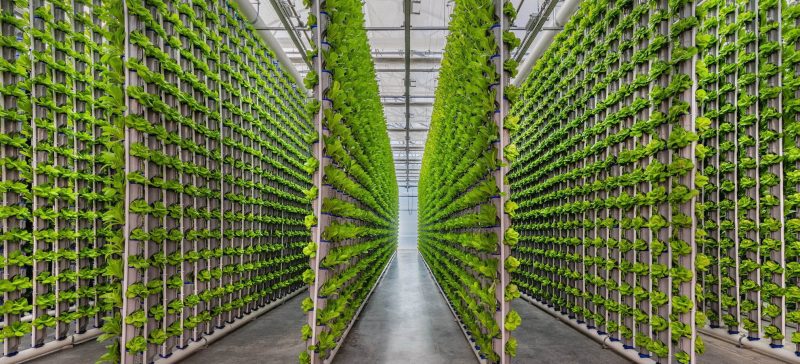Climate-smart innovations combined with efforts to achieve food self-sufficiency are fueling the swift expansion of the global vertical farming market. The Vertical Farming Market will generate US$ 6.92 billion in 2023 and will reach US$ 24.95 billion in 2030 thanks to a strong CAGR of 20.1% during the forecasted period.
The North American market has taken the lead because of substantial investments and technological supremacy combined with urban agriculture practices and the Asia-Pacific region shows the highest growth rate thanks to urbanisation alongside government programs and food security issues in Japan, Singapore, and India. The main companies active in this market are Agrilution GmbH, Aerofarm, Brightfarms Inc., Everlight Electronics Co., Ltd, Freight Farms, GrowUp Urban Farms Ltd., Green Sense Farms, LLC, and Vertical Farm Systems.
Vertical farming as the nexus of urban AgTech
Vertical farming merges advanced technologies to grow crops inside buildings without depending on usual planting seasons or large agricultural fields. The controlled settings enable continuous crop production throughout the year while minimising resource usage and maintaining superior quality consistency. Key systems used include:
- Hydroponic Systems: Stacked trays or towers use nutrient-rich water instead of soil to cultivate crops.
- Aeroponics: Aeroponics enhances root growth speed by misting them with nutrient solutions that boost oxygen exposure.
- Aquaponics: The aquaponics method integrates both fish farming and plant cultivation as part of a self-contained system.
- LED Grow Lights: Tailored light spectrums simulate ideal photosynthetic conditions.
- Climate Control Units: Sensors maintain optimal levels of temperature, humidity and CO₂ to support plant development.
Vertical farms utilise advanced technologies to achieve a 10-fold increase in food production per square foot compared to traditional farming methods.
Smart farming meets smart cities
Vertical farms markets are developing in close association with urban development strategies. Vertical farms are being incorporated into rooftops and warehouse spaces as well as unused commercial areas across global cities. The implementation of urban farms leads to reduced transportation needs for food delivery while decreasing environmental impact and providing access to fresh produce throughout all seasons.
The combination of IoT and AI technologies enhances vertical farming systems by allowing remote monitoring and controlling crop health tracking together with predicting yields and automating lighting and irrigation systems.
Sustainability at the core
The system of vertical farms uses up to 95% less water than traditional farming methods while making pesticide use unnecessary. Vertical farming combines minimal land usage with energy-efficient LED lighting to become a leading force in sustainable agriculture and climate-resilient food production systems. The system’s sustainability profile gets stronger through integration with renewable power sources and closed-loop nutrient recycling.
Barriers for scaling up
The vertical farming market holds potential but encounters several significant obstacles:
- High Initial Investment: The expenses for setting up necessary infrastructure and technology create barriers to small-scale adoption of vertical farms.
- Energy Dependence: The use of permanent artificial lighting combined with climate control systems demands substantial electrical power usage.
- Crop Limitations: Leafy greens lead production methods while research and development must progress for fruiting crops cultivation.
- Skilled Workforce Requirement: Vertical farming operations require expertise in agricultural technology combined with botany and data science skills.
Addressing these obstacles requires government policy backing together with incentive schemes and collaborations between public entities and private businesses.
Emerging trends & opportunities
- Retail Integration: Restaurants and grocery stores integrate vertical farming facilities directly into their facilities to ensure local sourcing.
- Container Farming: Vertical farms in shipping containers provide portable solutions for agricultural needs in extreme locations and emergency situations.
- Biophilic Design: Vertical farms integrate into urban landscapes to improve both visual appeal and air quality.
- Customised Crop Varieties: Specialised breeding programs for indoor-specific genetics improve both efficiency and flavor profiles.
- Blockchain for Traceability: The use of real-time tracking systems for food origins and farm environments enhances transparency which builds consumer confidence.
Conclusion: Vertical farming market anchors the future of urban food production
Vertical farming emerges as a vital direction for combining sustainable practices with technological advancements in modern agriculture. Vertical farms utilise sophisticated systems in small spaces to provide sustainable food solutions for urban populations with reduced environmental effects.
Vertical farming emerges as an essential response to the rising challenges of climate change and the escalating demands on food systems. Through dedicated investments and technology advancements along with strong policies vertical farming will establish itself as a fundamental element of future sustainable and smart food systems that maintain efficiency and resilience.
Source: London Daily News





















